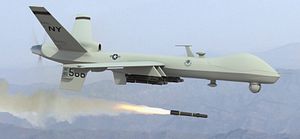The U.S. Air Force (USAF) will retire the General Atomics Aeronautical Systems MQ-1 Predator unmanned aerial vehicle (UAV) — until now the USAF’s main weapon of choice in UAV airstrikes — in early 2018 and replace it with the General Atomics Aeronautical Systems MQ-9 Reaper drone, the service revealed in a February 23 press release.
“While the MQ-1 has provided many years of service, the time has come for the Air Force to fly the more capable MQ-9 exclusively, and retire the MQ-1 in early 2018 to keep up with the continuously evolving battlespace environment,” according to the USAF. One reason for the change: The mission requirements for armed UAVs have changed. Unlike in the earlier years of the wars in Afghanistan and Iraq, UAVs are now more frequently used for close air support missions in which the MQ-9 exceeds the capabilities of the MQ-1.
“The MQ-9 is better equipped than the MQ-1 due to its increased speed, high-definition sensors and the ability to carry more munitions,” the press release notes. In addition, the Predator UAV was originally not designed to carry weapons, resulting in a mere 200-payload capacity in comparison to the Reaper’s 4,000 pounds. The MQ-9 can be armed with up to four laser-guided, air-to-ground 114 Hellfire missiles, or a mixture of 500-pound laser-guided GBU-12 Paveway II bombs and GBU-38 Joint Direct Attack Munitions (JDAM is a guidance kit that converts unguided bombs into precision-guided munitions.)
Flying one rather than two UAVs will also reduce costs since it no longer necessary to maintain two logistic and training pipelines for two separate aircraft. As of September 2015, the USAF has an inventory of 93 Reaper drones, according to a USAF fact sheet. In August 2016, the U.S. Department of Defense signed a $370.9 million contract for an additional 30 Reaper UAVs. All of the 30 new Reapers are expected to be delivered to the USAF by May 2019. The USAF’s Reaper force is currently controlled out of Creech Air Force Base in Nevada.
The USAF continues to face a shortage in drone pilots and was planning to add over 300 new drone operators by the end of 2016. As of now, the USAF flies around 60 to 70 sorties per day. That number is slated to increase in the years ahead. As I reported previously, the U.S. Department of Defense intends to substantially increase the number of drone surveillance flights in the South China Sea. However, many of these flights will be carried out by Global Hawk Long-Range surveillance UAVs rather than Reapers.
While it “is employed primarily against dynamic execution targets and [only] secondarily as an intelligence collection asset,” according to the USAF, the Reaper has also repeatedly proven useful in intelligence gathering and real-time reconnaissance missions. As The Diplomat reported last year, two MQ-9 Reaper UAVs have demonstrated their ability to track enemy missiles during a multilateral ballistic missile defense training exercise, involving Aegis destroyers from the United States, South Korea, and Japan in June 2016.

































